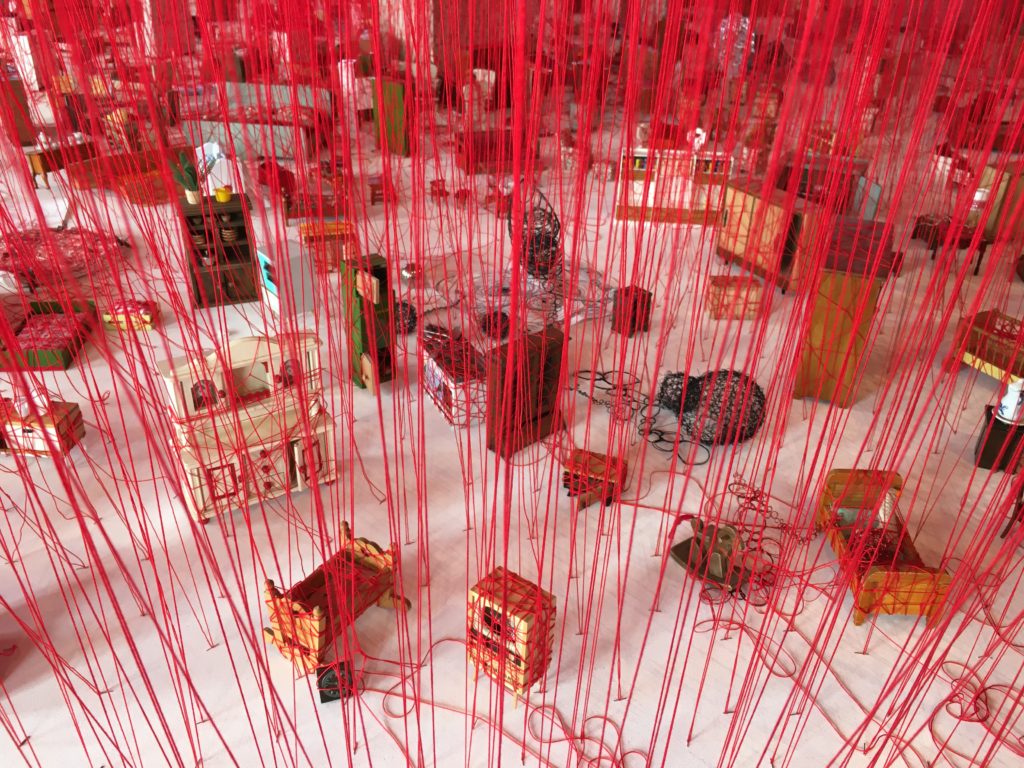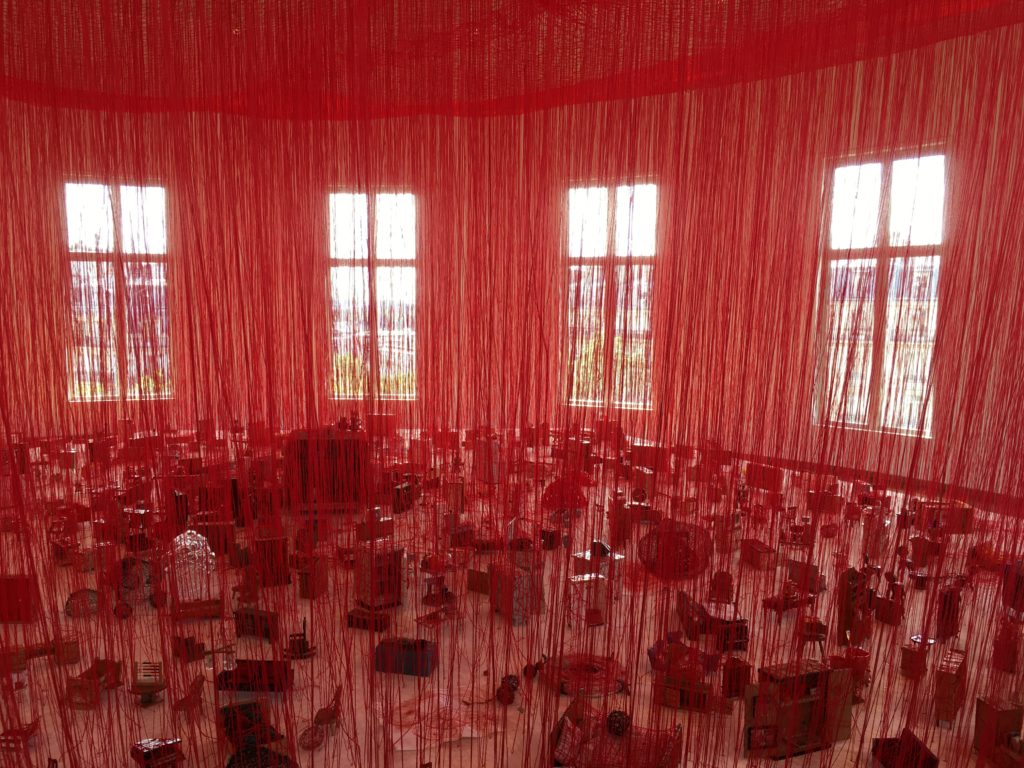by Lou Anmella-de Montalembert
Jusqu’au 6 juin, le musée Guimet invite l’artiste Chiharu Shiota pour sa 14ème Carte blanche à l’art contemporain.

Célèbre pour ses toiles spectaculaires, Chiharu Shiota incorpore également à ses installations des objets à la fois quotidiens et universels (chaussures, robes, lits, valises…) qui évoquent les traces et souvenirs de la vie, ainsi que le corps, soulignant son absence et sa mémoire. Lorsque ces objets sont immobilisés dans des toiles, les fils rouges, noirs ou blancs, loin de ne les tenir que prisonniers, constituent également les liens qui les unissent. Selon Chiharu Shiota, le fil peut représenter les sentiments ou les relations entre les êtres : tendus, noués ou coupés. Pour elle, le rouge et le noir sont les couleurs qui symbolisent le mieux ces connexions : rouge pour les liens familiaux, les origines, les racines, et noir pour lier des concepts et des idées plus universels. Depuis quelques années, l’artiste utilise également des fils de couleur blanche dans ses installations, couleur qu’elle assimile à l’interconnexion des individus ; immaculée pour symboliser un départ, une nouveauté. Perçues comme inquiétantes voire menaçantes, ou rassurantes telles des cocons protecteurs, les toiles de Chiharu Shiota troublent, insufflant poésie ou mélancolie à ceux qui les expérimentent.
Pour sa carte blanche au Musée Guimet, Chiharu Shiota a choisi de présenter un nouveau format d’installation, qu’elle a imaginé en période de confinement, suite aux contraintes liées à la pandémie de Covid. Ici, pas d’objets du quotidien à échelle humaine, mais une multitude de pièces de mobilier de poupée et de bibelots miniatures, enchevêtrés dans un entrelacs de fils rouges. Placée au centre de la Rotonde et surmontée de fils en tension, l’installation renvoie à des notions paradoxales vécues par tous récemment : rapprochement et séparation, connexion et isolement, protection et étouffement.
Née en 1972 à Osaka, au Japon, Chiharu Shiota vit et travaille aujourd’hui à Berlin, en Allemagne. Mondialement reconnue, l’artiste plasticienne a bénéficié de nombreuses expositions à travers l’Europe et le Japon au cours de ces quinze dernières années. En 2015, son intervention au sein du Pavillon japonais de la Biennale de Venise est très remarquée, et confirme sa position d’artiste internationale. Ses questionnements identitaires et universels, et la force visuelle de ses installations font écho auprès du plus grand nombre.
Carte blanche à Chiharu Shiota, jusqu’au 6 juin 2022, Musée Guimet, Paris
*ACA project remercie La Société des Amis du Musée Guimet pour leurs invitations à la visite privée de l’exposition.

Until June 6, the Guimet Museum invites the artist Chiharu Shiota for its 14th Carte blanche to contemporary art.
Famous for her spectacular webs, Chiharu Shiota also incorporates daily and universal objects (shoes, dresses, beds, suitcases, etc.) into her installations. They evoke the traces and memories of life, as well as the body, underlining its absence and its memory. When these objects are immobilized in webs, the red, black or white threads, far from only holding them prisoners, also constitute the links that unite them. According to Chiharu Shiota, the thread can represent feelings or relationships between human beings: tensed, knotted or cut. For her, red and black are the colors that best symbolize these connections: red for family ties, origins, roots, and black to link more universal concepts and ideas. For several years now, the artist has also been using white threads in her installations, a color that she associates with the interconnection of individuals; immaculate to symbolize a start, a novelty. Seen as disturbing, even threatening, or reassuring like protective cocoons, Chiharu Shiota’s webs upset, instilling poetry or melancholy in those who experience them.
For her carte blanche at the Guimet Museum, Chiharu Shiota has chosen to present a new installation format, which she imagined during the confinement caused by the Covid pandemic. Here, there is no everyday objects on a human scale, but a multitude of doll’s furniture pieces and miniature trinkets, tangled in an interlacing of red threads. Placed in the center of the Rotunda and surmounted by tensed threads, the installation refers to paradoxical notions experienced by all recently: proximity and separation, connection and isolation, protection and suffocation.
Born in 1972 in Osaka, Japan, Chiharu Shiota now lives and works in Berlin, Germany. Renowned worldwide, the visual artist has benefited from numerous exhibitions across Europe and Japan over the past fifteen years. In 2015, her intervention in the Japanese Pavilion of the Venice Biennale was a large success, and confirmed her position as an international artist. Her identity and universal questions, and the visual force of her installations resonate with the greatest number.
Carte blanche to Chiharu Shiota until June 6th, 2022, at Guimet Museum, Paris
*ACA Project would like to thank the Friends of Guimet for their invitation to the exhibition

